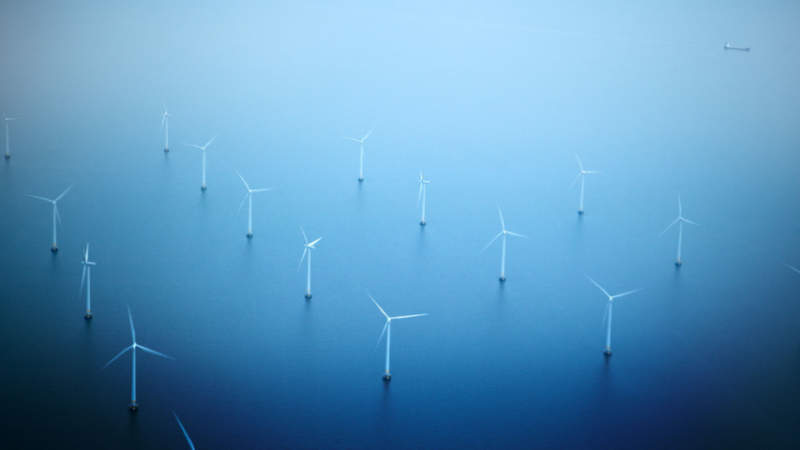Offshore wind continues to power up despite market uncertainty

Pic: Getty Images
Uncertainty is the new normal thanks to the COVID-19 pandemic that continues to sweep the globe with nearly 1.8 million cases worldwide and 111,828 deaths reported to date.
The impact of restrictions and lockdowns put in place to limit or moderate the spread of the virus have resulted in oil and gas companies slashing capital expenditure due to low oil prices.
However, the offshore wind sector might buck the trend to some degree with Norwegian state energy company Equinor proceeding with a 4.8 billion Norwegian crown ($730m) Hywind Tampen floating offshore wind turbine project to provide electricity to North Sea oil and gas platforms.
By reducing the use of gas turbines on these fields, the project is expected to reduce carbon dioxide emissions by more than 200,000 tonnes per year, or about equal to 100,000 cars.
There is delicious irony in Equinor proceeding with a renewable energy project that will be used to lower emissions from a fossil fuel project after the company cut its 2020 capital spending from $US10-11bn ($15.6-17.2bn) to $US8.5bn.
“As the whole industry is currently experiencing much uncertainty, it is vital that we progress projects that spur technology development in the renewables segment and create spin-off effects for the Norwegian supplier industry,” executive vice president for technology, projects and drilling Anders Opedal said.

Meanwhile, Danish company Ørsted remains optimistic about the prospects of the offshore wind sector.
The world’s largest offshore wind farm developer told Reuters that while the pandemic could delay project timelines, it would not influence investment decisions and general confidence in the sector.
It noted that its Taiwanese offshore wind projects had not been affected and that it was optimistic about its growth potential in Japan.
“There is strong fundamental need for offshore wind power in Japan,” Ørsted Asia-Pacific president Matthias Bausenwein said.
He pointed to the country’s plan to boost renewable energy, which included a legal framework for the development and construction of offshore wind facilities, and its need to replace some coal-fired and nuclear power.
Non-profit association World Forum Offshore Wind earlier this year noted that 5.2 gigawatts (GW) of generation capacity was installed in 2019, a 24 per cent increase over the previous year.
Total cumulative installed offshore capacity is forecast to reach 160GW by 2028 and while this might see some delays thanks to the impact of COVID-19, it still provides an indication on the potential growth of the sector.
More demand for the metals in wind turbines
And this is good news for rare earths explorers and producers – particularly those with significant neodymium-praseodymium (NdPr) content in their projects – as almost all offshore wind power generators use direct drive technology to increase efficiency and reduce the need for maintenance.
Direct drive motors require substantial use of neodymium-iron-boron (NdFeB) permanent magnets, with larger offshore towers using 500kg of NdFeB magnets per megawatt of output.
Arafura Resources (ASX:ARU), whose Nolans project in the Northern Territory is centred around NdPr, is particularly keen on the growth of the offshore wind sector with its general manager of sales and marketing Lloyd Kaiser telling Stockhead last month the company believed that the sector would continue to accelerate.
The company is continuing its metallurgical test work and is progressing pre-front end engineering and design activities.
Nolans has a reserve of 29.5 million tonnes grading 2.9 per cent total rare earth oxides.
Hastings Technology Metals (ASX:HAS) has just received Commonwealth environmental approvals for its Yangibana rare earths project in Western Australia.
The approvals include the construction and operation of an open pit rare earths mine, processing facility and associated support infrastructure.
Ionic Rare Earths (ASX:IXR) recently increased its ownership interest in the Makuutu rare earths project in Uganda to 31 per cent.
The company has the option to increase its stake in the project to 60 per cent once further milestones are completed.
Makutuu has an initial resource of 47.3 million tonnes grading 910 parts per million, or about 0.09 per cent, total rare earth oxides.
Earlier this month, Pensana Rare Earths’ (ASX:PM8) drilling intersected further high-grade zones at its Longonjo NdPr project in Angola.
The drill program is expected to allow the company to upgrade at least part of its inferred resource to the higher confidence indicated category so it can be included in the mine plan on completion of its definitive feasibility study work programs.
RareX (ASX:REE) owns the Cummins Range project in Western Australia that is believed to contain a significant percentage of NdPr.
The project is drill ready with all government approvals in place and heritage clearance currently being completed.
RareX recently signed up Talaxis, a specialist rare earths project developer and wholly-owned subsidiary of Noble Group, as a strategic partner to help drive development of the project.
NOW READ:
Could the coronavirus fuel development of non-Chinese rare earth projects?
Heavy rare earths prices are due some hefty gains in 2020, says Lynas
At Stockhead, we tell it like it is. While Arafura Resources, Ionic Rare Earths and RareX are Stockhead advertisers, they did not sponsor this article.
Related Topics

UNLOCK INSIGHTS
Discover the untold stories of emerging ASX stocks.
Daily news and expert analysis, it's free to subscribe.
By proceeding, you confirm you understand that we handle personal information in accordance with our Privacy Policy.








